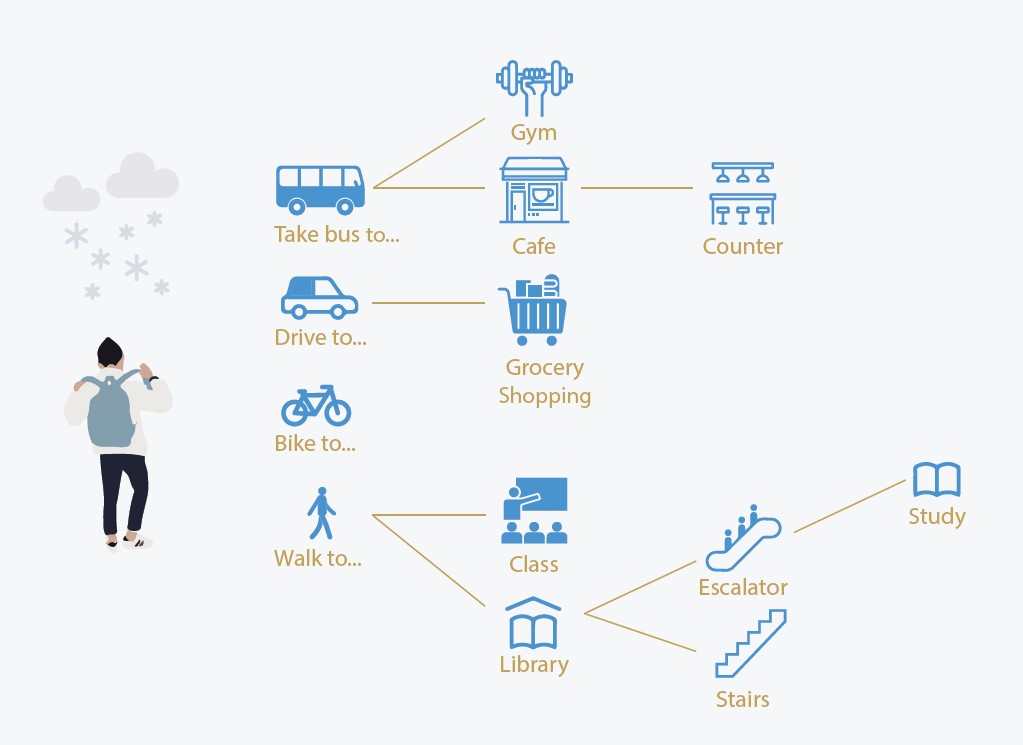︎ Walking for Better Learning
Modifying campus physical environment to elevate college students’ physical activity level and enhance learning capacity.
By Victoria Yu ︎


Hypothesis
Researchers reported that 40% to 50% of college students are physically inactive (PA) and health professionals could not effectively change PA habits of people of this age1. Yet, study shows that contemporary design of working and living environments have significantly reduced demand for PA and users do not meet the level of PA required for healthy fitness 2-6. Two strategies suggested by past researches include incorporating PA into daily routine activities via changing the physical surrounding environment and providing complimentary sophisticated services7-10. The benefits of sufficient amount of PA include enhanced memory and on-task behaviors given the increased level of blood flow and other biological changes while exercising11-12.
Researchers reported that 40% to 50% of college students are physically inactive (PA) and health professionals could not effectively change PA habits of people of this age1. Yet, study shows that contemporary design of working and living environments have significantly reduced demand for PA and users do not meet the level of PA required for healthy fitness 2-6. Two strategies suggested by past researches include incorporating PA into daily routine activities via changing the physical surrounding environment and providing complimentary sophisticated services7-10. The benefits of sufficient amount of PA include enhanced memory and on-task behaviors given the increased level of blood flow and other biological changes while exercising11-12.
- Why?
Among all exercises, walking might be the most accessible; despite its simplicity, walking could offer what other exercises could not since we could walk at our own pace which creates an unadulterated feedback look between the rhyme of our bodies and our mental state13.
- How?
Implementing
1. heated walkways that makes walking in snow easier
2. intercom stands that allow students to walk more safely at night with companions heading toward same destination
3. collaborating with school gyms to have instructors teach at department buildings to enhanceparticipation rate will help tie PA into students’ physical surrounding environment.
- What?
With elevated level of PA, college students should demonstrate better memory capability, attention span and general academic performance. Moreover, physical wellness also has positive correlation to innovative creativity, so PA should be even more promoted within departments that involve creativity.
- So What?
Impact:
students should be able to have reduced level of stress, better academic performance and more strokes of insight while they participate in generation of creative solutions inside and outside of classrooms.
Measure:
(walking, level of PA) street counter to count number of students using the walk way r steps taken from their phone data, PA class participation rate; (performance) students’ GPA, self-reported evaluation of creative solutions, timesheet to track productivity

Design to Outcomes
The proposed interventions will focus on
1. Modifying campus environment to enable it afford nicer, safer and easier walking experience
2. Making fitness classes more accessible outside the gyms.
3. I hope the proposed interventions also lead us to think about how PA could be better integrated into our daily routine activities.
︎
Works Cited
1. Keating, Xiaofen Deng, et al. “A Meta-Analysis of College Students Physical Activity Behaviors.” Journal of American College Health, vol. 54, no. 2, 2005, pp. 116–126., doi:10.3200/jach.54.2.116-126.
2. Humpel N, Owen N, Leslie E. Environmental factors associated with adults’ participation in physical activity: a review. Am J Prev Med. 2002;22:188-199.
3. King AC, Bauman A, Calfas K. Innovative approaches to understanding and influencing physical activity. Am J Prev Med. 2002;23(suppl): 1-108.
4. Orleans CT, Kraft MK, Marx JF, McGinnis JM. Why are some neighborhoods active and others not? Charting a new course for research on the policy and environmental determinants of physical activity. Ann Behav Med. 2003;25:77-79.
5. Saelens BE, Sallis JF, Frank LD. Environmental correlates of walking and cycling: findings from the transportation, urban design and planning literatures. Ann Behav Med. 2003;25:80-91.
6. Sallis JF, Bauman A, Pratt M. Environmental and policy interventions to promote physical activity. Am J Prev Med. 1998;15:379-397.
7. Sallis JF, Bauman A, Pratt M. Environmental and policy interventions to promote physical activity. Am J Prev Med. 1998;15:379-397.
8. Seefeldt V, Malina RM, Clark MA. Factors affecting levels of physical activity in adults. Sports Med. 2002;32:143-168.
9. Lombard DN, Lombard TN, Winett RA. Walking to meet health guidelines: the effect of prompting frequency and prompt structure. Health Psychol. 1995;14:164-170.
10. Marcus BH, Emmons KM, Simkin-Silverman LR, et al. Evaluation of motivationally tailored vs standard self-help physical activity interventions at the workplace. Am J Health Promot. 1998;12:246-253.
11. Stylianou, Michalis, et al. “Before-School Running/Walking Club: Effects on Student on-Task Behavior.” Preventive Medicine Reports, vol. 3, 2016, pp. 196–202., doi:10.1016/j.pmedr.2016.01.010.
12. Salas, Carlos R., et al. “Walking before Study Enhances Free Recall but Not Judgement-of-Learning Magnitude.” Journal of Cognitive Psychology, vol. 23, no. 4, 2011, pp. 507–513., doi:10.1080/20445911.2011.532207.
13. Jabr, Ferris. “Why Walking Helps Us Think.” The New Yorker, The New Yorker, 19 June 2017, www.newyorker.com/tech/annals-of-technology/walking-helps-us-think.